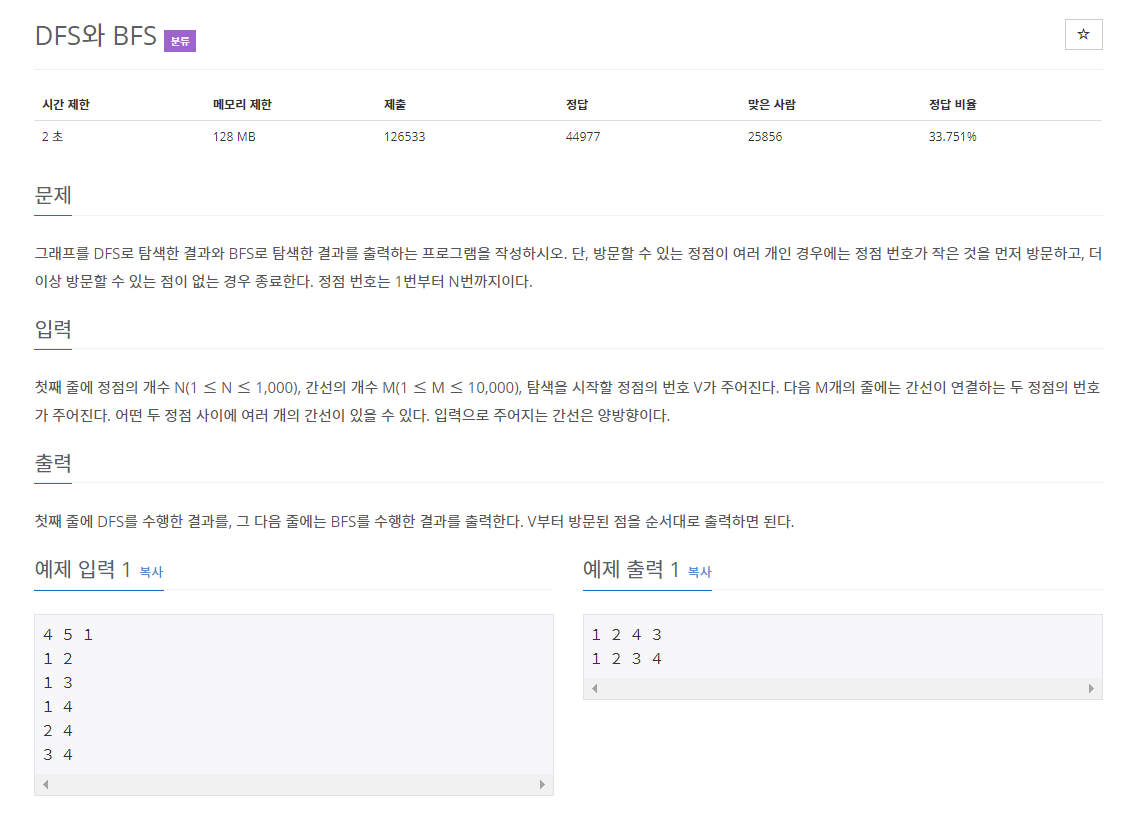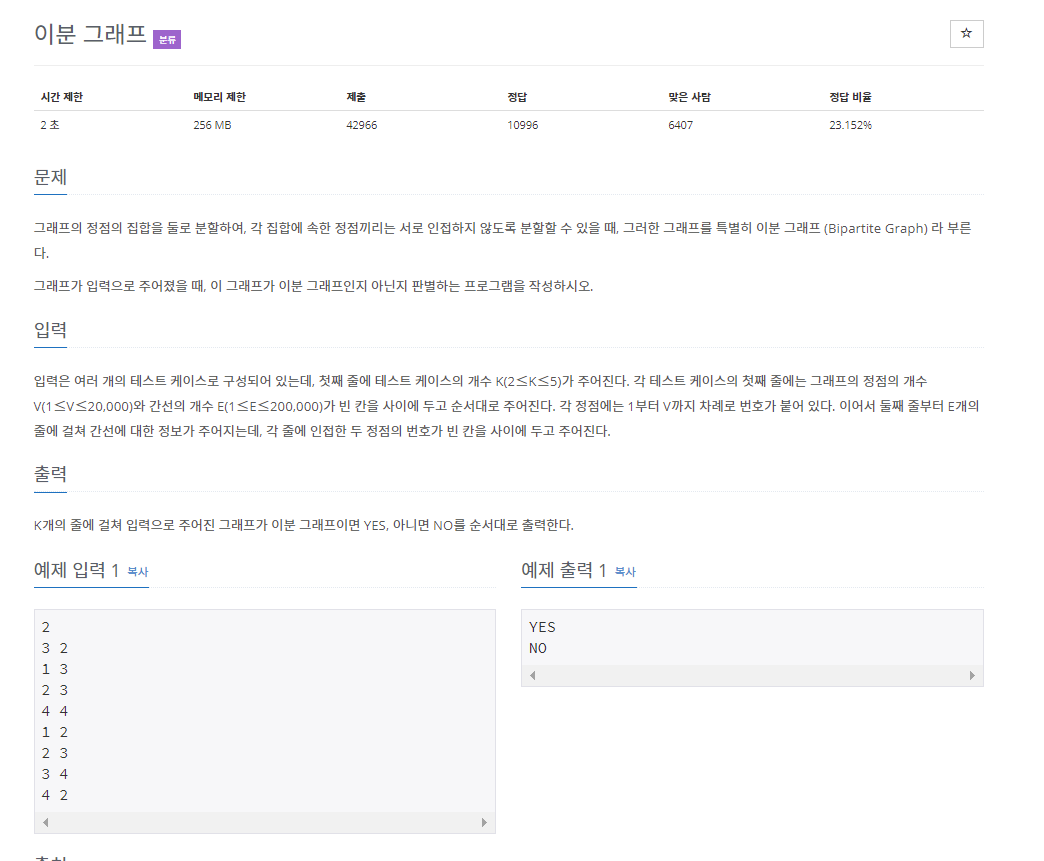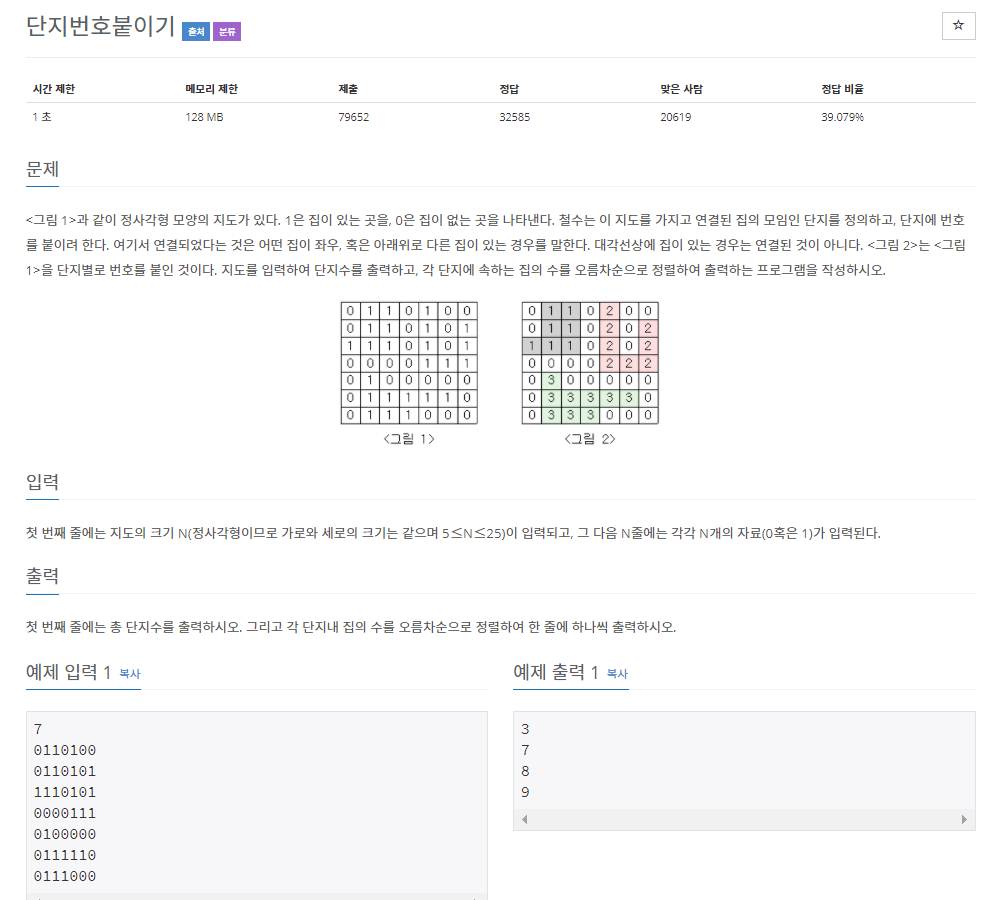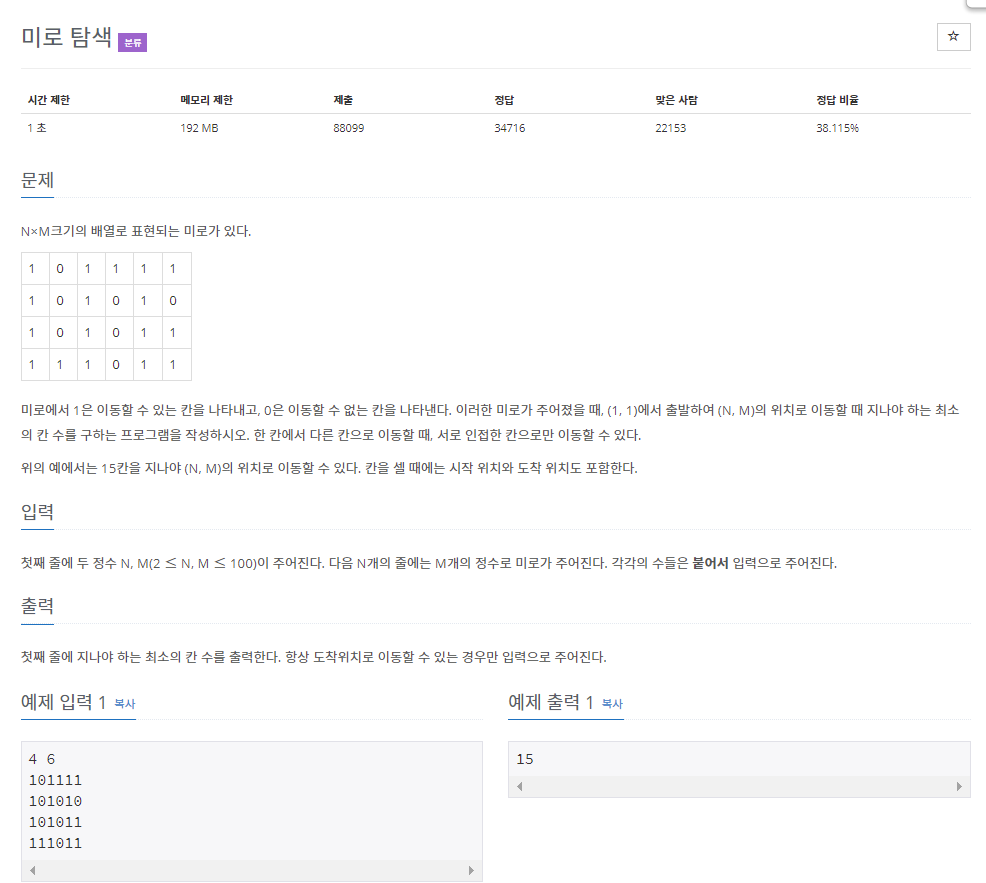
그래프의 탐색
목적 : 한 정점에서 시작해서 연결된 모든 정점을 한 번씩 방문하는 것.
DFS : 깊이 우선 탐색
-> 사람 1명(시작점) -> 돌아가야 할 스택
BFS : 너비 우선 탐색
-> 사람1명 -> 사람을 복제해서 ,,,
깊이 우선 탐색(DFS)
Depth First Search
스택을 이용해서 갈 수 있는 만큼 최대한 많이 가고, 갈 수 없으면 이전 정점으로 돌아간다.
- 정점을 방문했는지 방문하지 않았는지를 체크하는 배열이 필요함.
- check[i] : i를 방문했으면 1, 아니면 0
- 갈 수 있는 곳이 여러개 있을 때 어디로 가는지는 중요하지 않음.
- 다 돌아가서 갈 곳이 없으면 스택을 이용해서 원래의 정점으로 돌아감.
- 실제로는 스택 이용하지 않고, 재귀 함수를 이용
재귀 호출을 이용해서 구현.
인접행렬을 이용한 구현
DFS(X) -> X를 방문했다는 것.
void dfs(int x){
check[x] = true; //방문했다는 뜻.
for(int i=1; i<=n; i++){
if(a[x][i] == 1 && check[i] == false){
dfs(i); } } }
조건문 내용 x-> i
1) x와 i사이에 간선이 있음.
2) i를 방문한 적이 없음
-
각 정점마다 dfs 1번 호출. -> V번 (정점의 개수)
-
DFS함수의 복잡도 : V.
-
시간복잡도 : O(V^2)
인접리스트로 구할 때
void dfs(int x){
check[x]= true;
for(int i=0;i<a[x].size(); i++){
int y=a[x][i];
if(check[y] ==false){
dfs(y);
}}}1) x->i
a[x] = x와 연결된 모든 정점.
-> check[y] =false인 것만 확인해주면 된다. -
dfs(1) : 1과 연결된 간선의 개수와 같음.
-> 1과 연결된 모든 간선에 대해서 for문을 돌려서 검사를 하는 것.
-> 이런식으로 전부 다 계산하면 모든 정점에 대해서 검사를 하게 됨. -
시간복잡도 : O(E)
너비 우선탐색(BFS)
Breadth First Search
큐를 이용해서 지금 위치에서 갈 수 있는 것을 모두 큐에 넣는 방식.
큐에 넣을 때 방문했다고 체크해야한다.
- dfs에서 방문 = 함수의 호출.
but, BFS에서의 방문 = 큐에 넣을 때. - 이미 방문한 것을 또 방문하면 안됨!
- 그렇기 때문에 큐에 넣을 때 방문했다고 해야함.
- 큐가 비어있게 되면 탐색이 끝난 것임.
BFS의 구현은 큐를 이용해서 할 수 있음.(인접행렬)
- 목적 : 모든 정점을 한 1번씩 방문. 큐에 push. pop이 됨.
- 시간복잡도 : O(V^2)
**BFS 인접리스트를 사용하면 O(V+E)
DFS와 BFS(1260)

- 정렬해주어야 함.
import java.util.*;
class Main {
static ArrayList<Integer> arr[];
static boolean chk[];
public static void main(String[] args) {
Scanner sc = new Scanner(System.in);
int n = sc.nextInt();
int m = sc.nextInt();
int begin = sc.nextInt();
arr = new ArrayList[n+1];
for(int i=1;i<=n;i++) {
arr[i] = new ArrayList<Integer>();
}
for(int i=0;i<m;i++) {
int u = sc.nextInt();
int v = sc.nextInt();
arr[u].add(v);
arr[v].add(u);
}
//여기까지는 입력받고
for(int i=1;i<=n;i++) {
Collections.sort(arr[i]); //정렬
}
chk = new boolean[n+1];
dfs(begin);
System.out.println();
chk = new boolean[n+1];
bfs(begin);
System.out.println();
}
//dfs 함수. 재귀함수 이용해서 계속 호출하고 true(방문함)
public static void dfs(int x) {
if(chk[x]) {
return;
}
chk[x]=true;
System.out.print(x+" ");
for(int y : arr[x]) {
if(chk[y]==false) {
dfs(y);
}
}
}
//bfs 함수. queue 이용
public static void bfs(int x) {
Queue<Integer> q = new LinkedList<Integer>();
q.add(x);
chk[x] = true;
while(!q.isEmpty()) {
int a = q.remove();
System.out.print(a+" ");
for(int y : arr[a]) {
if(chk[y]==false) {
chk[y]=true;
q.add(y);
}
}
}
}
}연결요소(11724)

그래프가 나누어져 있지 않은 경우가 있을 수 있다.
나누어진 각각의 그래프를 연결 요소라고 한다.
연결 요소에 속한 모든 정점을 연결하는 경로가 있어야 한다.
또, 다른 연결 요소에 속한 정점과 연결하는 경로가 있으면 안된다.
- 연결 요소를 구하는 것은 DFS나 BFS 탐색을 이용해서 구할 수 있음.
import java.util.*;
class Main {
static ArrayList<Integer> arr[];
static boolean chk[];
public static void main(String[] args) {
Scanner sc = new Scanner(System.in);
int n = sc.nextInt();
int m = sc.nextInt();
arr = new ArrayList[n+1];
for(int i=1;i<=n;i++) {
arr[i] = new ArrayList<Integer>();
}
for(int i=0;i<m;i++) {
int u = sc.nextInt();
int v = sc.nextInt();
arr[u].add(v);
arr[v].add(u);
}
boolean c[] = new boolean[n+1];
int res=0;
for(int i=1;i<=n;i++) {
if(c[i]==false) {
dfs(arr,c,i);
res ++;
}
}
System.out.println(res);
}
public static void dfs(ArrayList<Integer> arr[], boolean chk[], int x) {
if(chk[x]) {
return;
}
chk[x]=true;
for(int y : arr[x]) {
if(chk[y]==false) {
dfs(arr,chk,y);
}
}
}
}-> 위에 코드에서 살짝만 변형했다,,
이분 그래프(1707)

그래프를 A와 B로 나눌 수 있으면 이분 그래프라고 한다.
A에 포함된 정점끼리 연결된 간선이 없음.
B에 포함된 정점끼리 연결된 간선이 없음.
모든 간선의 한 끝 점은 A에, 다른 끝 점은 B에 있어야 함.
- DFS / BFS 탐색으로 이분 그래프인지 아닌지 알아낼 수 있다.
import java.util.*;
class Main {
static ArrayList<Integer> arr[];
static boolean chk[];
public static void main(String[] args) {
Scanner sc = new Scanner(System.in);
int t = sc.nextInt();
while(t-->0) {
int n = sc.nextInt();
int m = sc.nextInt();
arr = new ArrayList[n+1];
for(int i=1;i<=n;i++) {
arr[i] = new ArrayList<Integer>();
}
for(int i=0;i<m;i++) {
int u = sc.nextInt();
int v = sc.nextInt();
arr[u].add(v);
arr[v].add(u);
}
int color[] = new int[n+1];
boolean c = true;
for(int i=1;i<=n;i++) {
if(color[i]==0) {
if(dfs(arr, color,i,1)==false) {
c=false;
}
}
}
if(c) {
System.out.println("YES");
}else {
System.out.println("NO");
}
}
}
public static boolean dfs(ArrayList<Integer> arr[], int color[], int x,int c) {
color[x]=c;
for(int y : arr[x]) {
if(color[y]==0) {
if(dfs(arr,color,y,3-c)==false) {
return false;
}
}else if(color[y]==color[x]) {
return false;
}
}
return true;
}
}단지번호붙이기(2667)

정사각형 모양의 지도가 있다.
0은 집이 없는 곳, 1은 집이 있는 곳.
지도를 가지고 연결된 집의 모인인 단지를 정의하고 단지에 번호를 붙인다.
연결 : 좌우 아래 위로 집이 있는 경우.
- 단지 : 연결요소의 개수.
- 단지내의 개수 : 정점의 개수.
-
그래프 문제를 풀 때 인접리스트를 만듬 -> 한 정점과 연결된 다른 정점 (간선) 효율적으로 찾기 위해서.
-
DFS나 BFS 알고리즘을 이용해서 어떻게 이어졌는지 확인할 수 있다.
d[i][j] = (i,j)를 방문안했으면 0, 아니면 1 -
bfs는 방법이 정해져 있음. 시작점 넣고, 큐가 비어있지 않으면 다음거 넣고 ~ 이런식으로. 그래서 비슷한 형태의 코드를 가짐.
-
dx = [1,-1,0,0]
-
dy = [ 0,0,1,-1]
상하좌우만 들어있으면 됨.
import java.util.*;
class Pair{
int x;
int y;
Pair(int x, int y){
this.x = x;
this.y = y;
}
}
class Main {
static final int dx[]= {0,0,1,-1};
static final int dy[]= {1,-1,0,0};
public static void main(String[] args) {
Scanner sc = new Scanner(System.in);
int n = sc.nextInt();
int cnt=0;
int d[][] = new int[n][n];
sc.nextLine();
int arr[][] = new int [n][n];
for(int i=0;i<n;i++) {
String str = sc.nextLine();
for(int j=0;j<n;j++) {
arr[i][j] = str.charAt(j)-'0';
}
}
for(int i=0;i<n;i++) {
for(int j=0;j<n;j++) {
if(arr[i][j] == 1 && d[i][j]==0) {
dfs(arr, d, i, j, ++cnt, n);
}
}
}
int res[] = new int[cnt];
for(int i=0;i<n;i++) {
for(int j=0;j<n;j++) {
if(d[i][j] != 0)
res[d[i][j]-1]++;
}
}
Arrays.sort(res);
System.out.println(cnt);
for(int i=0;i<cnt;i++) {
System.out.println(res[i]);
}
}
public static void dfs(int arr[][],int d[][],int x,int y, int cnt, int n) {
d[x][y]= cnt;
for(int k=0; k<4; k++) {
int nx= x+dx[k];
int ny= y+dy[k];
if(0<=nx && nx <n && 0 <=ny && ny < n) {
if(arr[nx][ny] == 1 && d[nx][ny] == 0) {
dfs(arr, d, nx, ny, cnt, n);
}
}
}
}
}=> 이런식의 문제를 많이 푸는 연습을 해야할 것 같음...ㅠ-ㅠ
미로 검색(2178)

(1,1)에서 (N,M)으로 가는 가장 빠른 길을 구하는 문제
DFS 탐색으로는 풀 수 없다.
BFS 탐색을 사용해야 한다.
BFS는 단계별로 진행된다는 사실을 이용
- 최단 경로 => BFS 탐색.
- 가중치가 1일 때만 최단 경로를 구할 수 있음.
- 방문여부만 검색하는 것이 아니라, 거리를 넣어줘야해서 이차원배열로 풀어야함.
- dist[][];
- chk[][] , dist[][] 두 개의 배열 사용.
